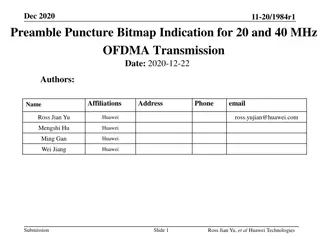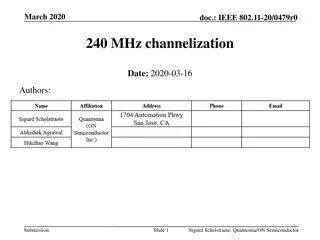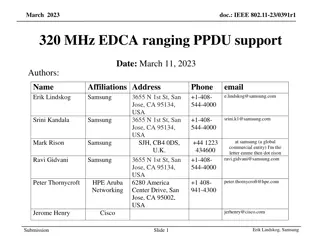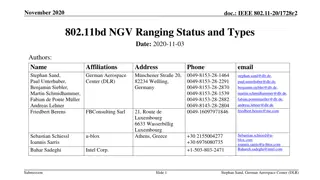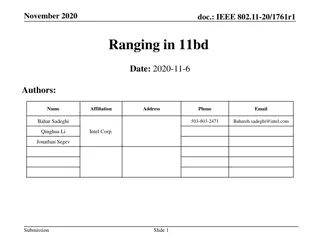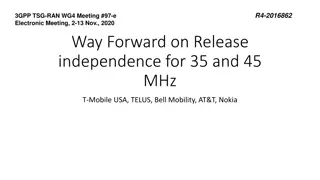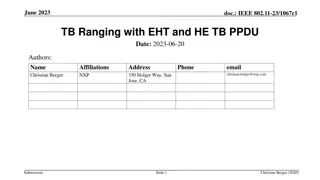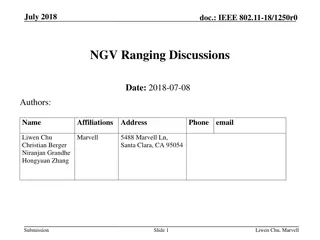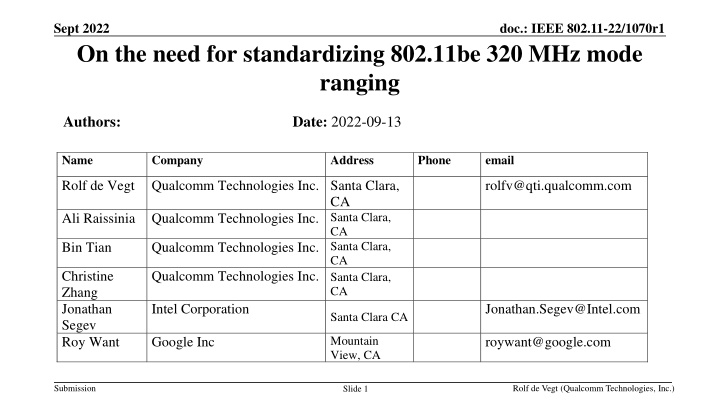
Standardizing 802.11be 320 MHz Mode Ranging - Importance and Recommendations
Explore the need for standardizing 802.11be's 320 MHz mode ranging in September 2022. Learn about the benefits, market context updates, and the recommended path for standardization. Discover how expanding frequency bandwidth can enhance wireless ranging accuracy significantly.
Download Presentation

Please find below an Image/Link to download the presentation.
The content on the website is provided AS IS for your information and personal use only. It may not be sold, licensed, or shared on other websites without obtaining consent from the author. If you encounter any issues during the download, it is possible that the publisher has removed the file from their server.
You are allowed to download the files provided on this website for personal or commercial use, subject to the condition that they are used lawfully. All files are the property of their respective owners.
The content on the website is provided AS IS for your information and personal use only. It may not be sold, licensed, or shared on other websites without obtaining consent from the author.
E N D
Presentation Transcript
Sept 2022 On the need for standardizing 802.11be 320 MHz mode ranging doc.: IEEE 802.11-22/1070r1 Authors: Date: 2022-09-13 Name Company Address Phone email Rolf de Vegt Qualcomm Technologies Inc. Santa Clara, rolfv@qti.qualcomm.com CA Qualcomm Technologies Inc. Santa Clara, Ali Raissinia CA Qualcomm Technologies Inc. Santa Clara, Bin Tian CA Christine Zhang Jonathan Segev Roy Want Qualcomm Technologies Inc. Santa Clara, CA Santa Clara CA Intel Corporation Jonathan.Segev@Intel.com Mountain View, CA Google Inc roywant@google.com Submission Rolf de Vegt (Qualcomm Technologies, Inc.) Slide 1
September 2022 doc.: IEEE 802.11-22/1070r1 Topics Introduction Importance of 320 MHz bandwidth mode ranging Updated Market Context for 802.11 Fine Timing Measurement Standardization options and recommendation Submission Slide 2
September 2022 doc.: IEEE 802.11-22/1070r1 Introduction The 802.11az Next Generation Positioning project is nearing completion and is using 802.11ax as baseline and support up to 160 MHz ranging 802.11be is adding 320 MHz bandwidth operating modes, the use of which can further enhance accuracy of 802.11 FTM ranging This submission briefly discusses: The benefits of adding 320 MHz FTM operation to the 802.11 set of standards Some recent additional market context for 802.11 FTM A recommended standardization path for 320 MHz ranging This document was presented and reviewed in TGaz at the July Montreal meeting After positive feedback from the group, draft PAR (doc 22/1325) and CSD (doc 22/1353) documents have been developed Submission Slide 3
September 2022 doc.: IEEE 802.11-22/1070r1 Role of Frequency Bandwidth in Ranging Performance Four performance drives for wireless ranging accuracy:* Frequency Bandwidth Use of Multi-Antenna Technology Transmit Power Receiver Sensitivity Expanding the max frequency bandwidth assumed for 802.11az (160 MHz) to 320 MHz is expected to further improve accuracy of 802.11 ranging A conservative estimate is that based on Qualcomm internal analysis is that going from 160 Mode to 320 MHz will lead to a 30% increase in accuracy E.g. if the 90th percentile accuracy is 100 cm in the case of 160 MHz operation, it would be 70 cm for 320 MHz operation * See: https://www.qualcomm.com/content/dam/qcomm-martech/dm-assets/documents/wi-fi_location_white_paper_finalv2.pdf Submission Slide 4
September 2022 doc.: IEEE 802.11-22/1070r1 Updated Market Context for 802.11 Fine Timing Measurements New market context that emerged since 802.11 Rev mc FTM was standardized and 802.11az got started: Broader market and standards interest for the D2D ranging category from adjacent technology areas, e.g.: UWB, e.g. 802.15.4z and ongoing 802.15.4ab Bluetooth SIG - HADM (High Accuracy Distance Measurement) 3GPP CCC (Connected Car Consortium) Growing importance for 802.11 based technologies of the dimension of range / distance over which ranging measurements can be conducted Ability to measure range over longer distances sets 802.11 technologies apart from some of the other connectivity technologies Important new use case emerging to assist in geo location for 6GHz Standard Power Access Points for AFC operation (Automated Frequency Coordination) Submission Slide 5
September 2022 doc.: IEEE 802.11-22/1070r1 Some measured results of FTM ranging at larger distances Wi-Fi 5 GHz VHT160 LoS ranging data was collected in Qualcomm Santa Clara campus from 10 meters to 220 meters at a step of 10 meters RSSI dropped to around sensitivity point at 220 meters. At 230 meters, due to low RSSI, could not set up Wi-Fi 160 MHz connection The RTT accuracy was consistent at all distances. Without averaging, the 90th percentile ranging error is 97 cm, and with 32x averaging, the 90th percentile ranging error is 20 cm Below table shows the 90th percentile ranging error at each location. This is without averaging Submission Slide 6
September 2022 doc.: IEEE 802.11-22/1070r1 Standard Power 6 GHz adds an important new Use Case for Wi-Fi FTM Ranging Technology To operate in the 6GHz band at Standard Power Levels (Outdoor and Indoor), e.g.at up to 36 dBm in the US or Canada Automated Frequency Coordination (AFC) is required To obtain the set of allowed frequencies from and AFC system, an AP needs to submit its geo location coordinates The FCC rules prescribe that the geo location coordinates need to be determined by either an internal geolocation capability or an integrated capability to securely connect to an external geolocation devices or service * GPS is seen as a likely candidate for providing internal geolocation capabilities, however: Not every AP will be able to obtain a GPS fix , e.g. when installed deep inside a building Not every 6GHz capable AP may come equipped with GPS capabilities Wi-Fi Fine Timing Measurement Ranging capabilities for AP to AP distance measurement can assist in providing location data to AP s that cannot obtain location information through other means Client to AP distance measurement may also be useful if a client is used as the source of geolocation data *Source: FCC 2020 R&O, 15.407(k)(9) Submission Slide 7
September 2022 doc.: IEEE 802.11-22/1070r1 6GHz AFC FTM Ranging Use Case, Further explanation = AP with known position = AP that not able to generate its location through internal capabilities = Wi-Fi Fine Timing Measurement Ranging Submission Slide 8
September 2022 doc.: IEEE 802.11-22/1070r1 320 MHz Standardization Options and Recommendation Option TG az TG me Considerations Incompatible with the 802.11ax baseline requirement Rev me does not include .11be, would have to wait for the Rev mf timeframe to address it as part of a maintenance project Focus of .11bf is sensing, a related but separate topic, would disrupt .11bf scope and timeline Would be a distraction; would expand the scope of .11be and likely extend the timeline; workload is already very high With the .11az work efforts wrapping up, a focused project as a follow on seems to make sense. Need for tight scope and timeline management TG bf TG be Stand Alone New Project Recommendation is to develop a PAR and CSD for a stand alone Taskgroup for the purpose of standardizing 320 MHz mode ranging operation Submission Slide 9


